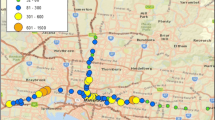Abstract
Soil studies, conducted in Maryland, Minnesota and Louisiana, have described the urban pattern of lead contamination. They have shown that the highest amounts of lead cluster within the interior of the largest cities. The results of the New Orleans urban patterns of distribution of soil lead provided the basis for further study. The hypothesis was tested that elementary school properties have the same pattern of soil lead contamination as their neighbouring residential communities. Thirty New Orleans Public Elementary Schools were selected for this study. Surface samples (2.5 cm or 1 inch depth) were collected from playgrounds and next to entrances of each school. Results showed that soil lead on school properties follows the same relative contamination patterns (p‐value ≤ 10−5) as soil lead on residential properties of neighbouring communities. Schools however, have significantly lower lead contamination than the neighbouring residential properties. Inner‐city school properties present a higher risk of soil lead exposure than mid and outer‐city schools. Soils next to inner‐city school entrances showed the highest lead, with 18.5% having concentrations over 400 μg g−1. Systematic landscaping around the school entrances would significantly reduce the hazard from lead dust contaminated soils.
Similar content being viewed by others
References
Annest, J. L.: 1983, Trends in the blood lead levels of the U.S. population: The second National Health and Nutrition Examination Survey (NHANES II) 1976–1980. In: M. Rutter and R. R. Jones (eds) Lead Versus Health: Sources and Effects on Low Level Lead Exposure, John Wiley, New York, pp. 33-58.
ATSDR: 1988, Agency for Toxic Substances and Disease Registry, The Nature and Extent of Lead Poisoning in Children in the United States: A Report to Congress. U.S. Public Health Service, Atlanta.
Bourgoin, E. P., Evans, D. R., Cornett, J. R., Lingard, S. M. and Quattrone, A. J.: 1993, Lead content in 70 brands of dietary calcium supplements. American Journal of Public Health 83, 1155-1160.
Brody D. J., Pirkle, J. L., Kramer, R. A., Flegal, K. M., Matte, T. D., Gunter, E. W. and Paschal, D. C.: 1994, Blood lead levels in the U.S. population: phase 1 of the third National Health and Nutritional Examination Survey (NHANES III, 1988–1991). Journal of the American Medical Association 272(4), 277-283.
Charney, E., Sayre, J. and Coulter, M.: 1980, Increased lead absorption in inner city children: Where does the lead come from?, Pediatrics 65, 226-231.
EPA: 1994, Revised Interim Soil Lead Guidance for CERCLA Sites and RCRA Corrective Action Facilities. Memorandum from Elliott P. Laws, OWSWER Directive # 9355. 4–12, July 14, 1994. See also, RCRA Corrective Action Subpart 5 rule (July 27, 1990, 55 Federal Register 30798).
Hammond, P. B.: 1982, Metabolism of lead. In: J. J. Chisolm and D. M. O'Hara (ed.) Lead Absorption in Children, Urban & Schwarzenberg, Baltimore, pp. 11-20.
Mielke, H. W., Viverette, L., Brisco, M., Scott, L., Gonzales, C. and Schaefer, J.: 1997, Surface dust on hands as a method for assessing and preventing childhood lead exposure. In: B. L. Johnson, C. Xintaras, J. S. Andrews, Jr. (eds) Hazardous Waste: Impacts on Human and Ecological Health, Proceedings of the 2nd International Conference on Hazardous Waste, Agency for Toxic Substances and Disease Registry, Princeton Scientific Publishing Co., Inc., Princeton, NJ, pp. 151-155.
Mielke, H. W.: 1993, Lead Dust Contaminated U.S.A. Cities: Comparison of Louisiana and Minnesota, Applied Geochemistry, Suppliment Issue Number 2, 257-261.
Mielke, H. W., Anderson, J. C., Berry, K. J., Mielke, P. W., Jr., Chaney, R. L. and Leech, M.: 1983, Lead concentrations in inner-city soils as a factor in the child lead problem. American Journal of Public Health 73(12), 1366-1369.
Mielke, H. W.: 1994, Lead in New Orleans soils: new images of an urban environment. Environmental Geochemistry and Health 16(3/4), 123-128.
Mielke, H. W. and Adams, J. L.: 1989, Environmental Lead Risk in the Twin Cities, Minneapolis: Center for Urban and Regional Affairs, University of Minnesota.
Mielke, H. W., Adams, J. L., Reagan, P. L. and Mielke, P. W.: 1989, Soil-dust lead and childhood lead exposure as a function of city size and community traffic flow: The case for lead abatement in Minnesota, Environmental Geochemistry and Health, Supplement 9, 253-271.
Mielke, H. W., Adams, J. E., Huff, B., Pepersack, J., Reagan, P. L., Stoppel, D. and Mielke, P. W.: 1991, Dust control as a means of reducing inner-city childhood Pb exposure. Trace Substances in Environmental Health 25, 121-128.
Mushak, P., Davis, J. M., Crocetti, A. F. and Grant, L. D.: 1989, Prenatal and postnatal effects of low-level lead exposure: integrated summary of a report to the U.S. Congress on childhood lead poisoning. Environmental Research 50, 11-36.
Mushak, P. and Crocetti, A. F.: 1989, Methods for reducing lead exposure in young children and other risk groups. An integrated summary of a report to the U.S. Congress on childhood lead poisoning, Environmental Health Perspective 89, 125-135.
National Center for Health Statistics: 1984, Blood lead levels for persons ages 6 months — 74 years: United States, 1976–1980. Vital & Health Statistics 11, 233.
Pirkle, J. L., Brody, D. J., Gunter, E.W., Kramer, R. A., Paschal, D.C., Flegal, K.M. and Matte, T. D.: 1994, The decline in blood lead levels in the United States: The National Health and Nutritional Examination Surveys (NHANES), Journal of the American Medical Association, 272(4), 284-291.
Sayre, J.: 1981, Dust lead contribution to lead in children. In: D. R. Layman, L. G. Piantanida and J. F. Cole (eds), Environmental Lead, Academic Press, New York, pp. 23-40.
Viverette, L., Mielke, H. W., Brisco, M., Dixon, A., Schaefer, J. and Pierre, K.: 1996, Environmental health in minority and other underserved populations: benign methods for identifying lead hazards at day care centres of New Orleans, Environmental Geochemistry and Health 18, 41-45.
Rights and permissions
About this article
Cite this article
Higgs, F.J., Mielke, H.W. & Brisco, M. Soil Lead at Elementary Public Schools: Comparison Between School Properties and Residential Neighbourhoods of New Orleans. Environmental Geochemistry and Health 21, 27–36 (1999). https://doi.org/10.1023/A:1006552627021
Issue Date:
DOI: https://doi.org/10.1023/A:1006552627021




